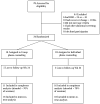Group versus individual phone-based obesity treatment for rural women
- PMID: 19962115
- PMCID: PMC2823259
- DOI: 10.1016/j.eatbeh.2009.08.002
Group versus individual phone-based obesity treatment for rural women
Abstract
Rural women have among the highest rates of obesity and sedentary lifestyle, yet few studies have examined strategies for delivering state-of-the-art obesity treatment to hard-to-reach rural areas. The purpose of this pilot trial was to examine the impact and cost-effectiveness of a 6-month behavioral weight loss program delivered to rural women by phone either one-on-one with a counselor or to a group via conference call. Thirty-four rural women (mean BMI=34.4, SD=4.6) were randomized to group phone-based treatment or individual phone-based treatment. Completers analysis showed that weight loss was greater in the group condition (mean=14.9 kg=, SD=4.4) compared to the individual condition (mean=9.5 kg, SD=5.2; p=.03). Among the total sample, 62% of participants in the group condition achieved the 10% weight loss goal compared to 50% in the individual condition, and group treatment was found to be more cost-effective. Future research is warranted to examine the benefits of group phone-based treatment for long-term management of obesity among rural populations.
Conflict of interest statement
Dr. Donnelly has received grants and products, and Dr. Befort received products for the current study, from Health Management Resources Corporation. All other authors declare that they have no conflicts of interest.
Comment in
-
Group therapy for patients suffering from eating disorders.Int J Group Psychother. 2012 Jul;62(3):473-6. doi: 10.1521/ijgp.2012.62.3.473. Int J Group Psychother. 2012. PMID: 22676792 No abstract available.
Similar articles
-
Protocol and recruitment results from a randomized controlled trial comparing group phone-based versus newsletter interventions for weight loss maintenance among rural breast cancer survivors.Contemp Clin Trials. 2014 Mar;37(2):261-71. doi: 10.1016/j.cct.2014.01.010. Epub 2014 Jan 31. Contemp Clin Trials. 2014. PMID: 24486636 Free PMC article. Clinical Trial.
-
Effect of Behavioral Therapy With In-Clinic or Telephone Group Visits vs In-Clinic Individual Visits on Weight Loss Among Patients With Obesity in Rural Clinical Practice: A Randomized Clinical Trial.JAMA. 2021 Jan 26;325(4):363-372. doi: 10.1001/jama.2020.25855. JAMA. 2021. PMID: 33496775 Free PMC article. Clinical Trial.
-
The drop it at last study: six-month results of a phone-based weight loss trial.Am J Health Promot. 2010 Jul-Aug;24(6):378-83. doi: 10.4278/ajhp.080826-QUAN-161. Am J Health Promot. 2010. PMID: 20594094 Free PMC article. Clinical Trial.
-
Comparing Three Ways to Offer a Weight Management Program to Patients Living in Rural Areas—The RE-POWER Study [Internet].Washington (DC): Patient-Centered Outcomes Research Institute (PCORI); 2021 Jul. Washington (DC): Patient-Centered Outcomes Research Institute (PCORI); 2021 Jul. PMID: 38771923 Free Books & Documents. Review.
-
Systematic reviews of and integrated report on the quantitative, qualitative and economic evidence base for the management of obesity in men.Health Technol Assess. 2014 May;18(35):v-vi, xxiii-xxix, 1-424. doi: 10.3310/hta18350. Health Technol Assess. 2014. PMID: 24857516 Free PMC article. Review.
Cited by
-
Equivalent weight loss for weight management programs delivered by phone and clinic.Obesity (Silver Spring). 2013 Oct;21(10):1951-9. doi: 10.1002/oby.20334. Epub 2013 May 25. Obesity (Silver Spring). 2013. PMID: 23408579 Free PMC article. Clinical Trial.
-
Weight loss success in metabolic syndrome by telephone interventions: results from the SHINE Study.J Gen Intern Med. 2013 Dec;28(12):1620-8. doi: 10.1007/s11606-013-2529-7. Epub 2013 Jul 11. J Gen Intern Med. 2013. PMID: 23843020 Free PMC article. Clinical Trial.
-
Social media for health promotion and weight management: a critical debate.BMC Public Health. 2018 Jul 28;18(1):932. doi: 10.1186/s12889-018-5837-3. BMC Public Health. 2018. PMID: 30055592 Free PMC article.
-
Delivery of telehealth nutrition and physical activity interventions to adults living in rural areas: a scoping review.Int J Behav Nutr Phys Act. 2023 Sep 15;20(1):110. doi: 10.1186/s12966-023-01505-2. Int J Behav Nutr Phys Act. 2023. PMID: 37715234 Free PMC article.
-
Reaching the hard-to-reach: a systematic review of strategies for improving health and medical research with socially disadvantaged groups.BMC Med Res Methodol. 2014 Mar 25;14:42. doi: 10.1186/1471-2288-14-42. BMC Med Res Methodol. 2014. PMID: 24669751 Free PMC article.
References
-
- Anderson RA, Rees CS. Group versus individual cognitive–behavioural treatment for obsessive–compulsive disorder: A controlled trial. Behavior Research and Therapy. 2007;45(1):123–137. - PubMed
-
- Ashley JM, St Jeor ST, Perumean-Chaney S, Schrage J, Bovee V. Meal replacements in weight intervention. Obesity Research. 2001;9(Suppl 4):312S–320S. - PubMed
-
- Bandura A. Social foundation of thought and action: A social cognitive theory. Englewood Cliffs, NJ: Prentice Hall; 1986.
-
- Bastien CH, Morin CM, Ouellet MC, Blais FC, Bouchard S. Cognitive–behavioral therapy for insomnia: Comparison of individual therapy, group therapy, and telephone consultations. Journal of Consulting and Clinical Psychology. 2004;72(4):653–659. - PubMed
-
- Brown RL, Leonard T, Saunders LA, Papasouliotis O. A two-item conjoint screen for alcohol and other drug problems. Journal of the American Board of Family Practice. 2001;14(2):95–106. - PubMed
Publication types
MeSH terms
Grants and funding
LinkOut - more resources
Full Text Sources
Medical
Miscellaneous


